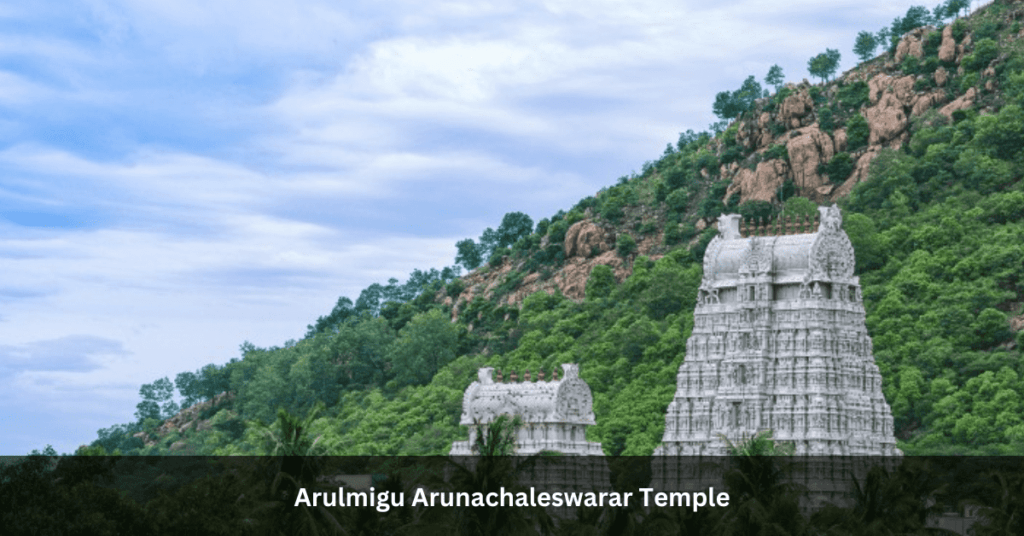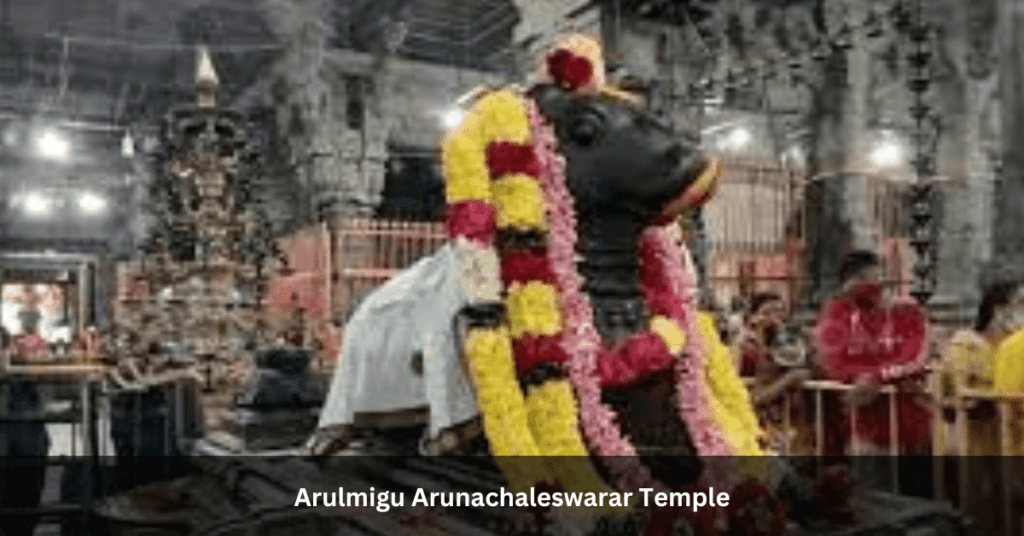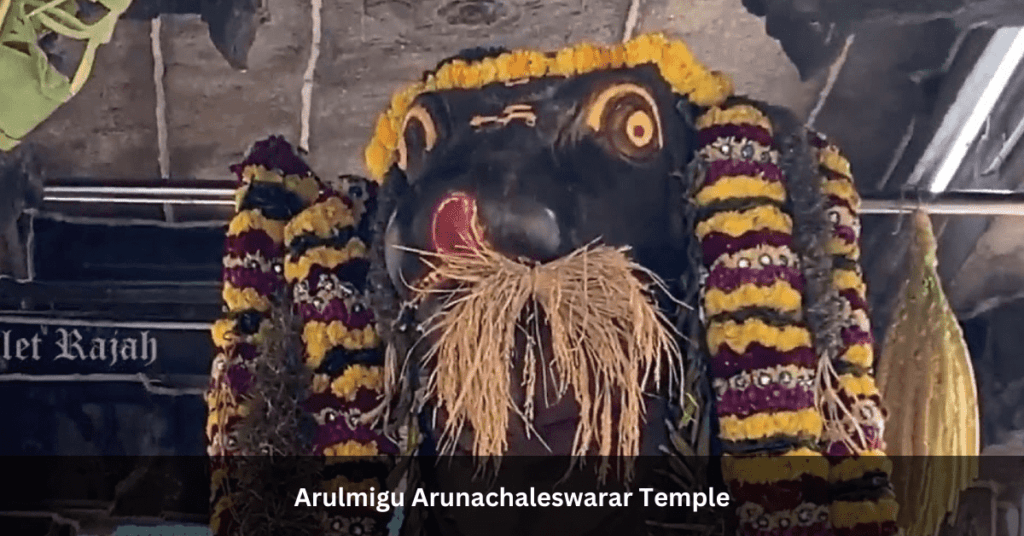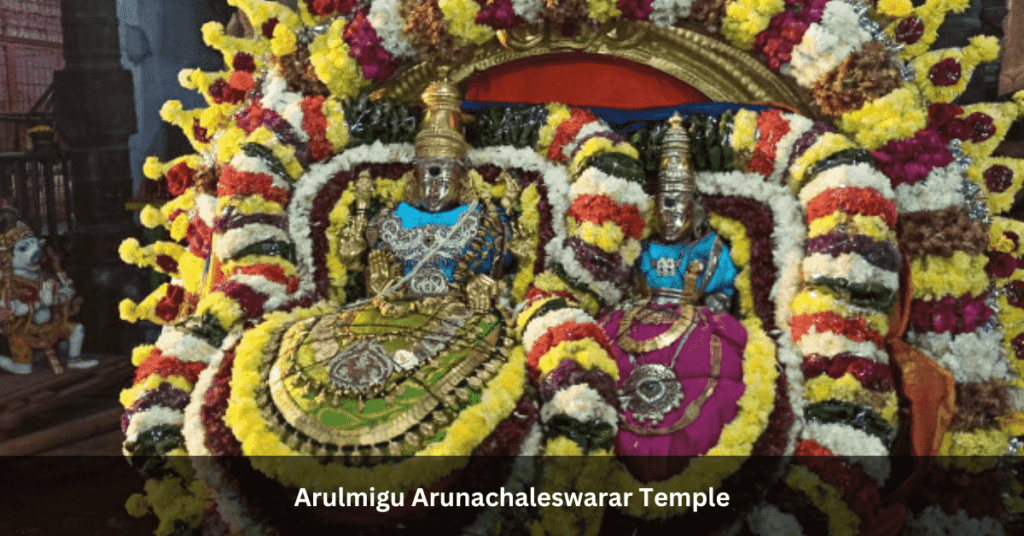Introduction -Arulmigu Arunachaleswarar Temple, located in Thiruvannamalai in Tamil Nadu, India, is a sacred abode that holds deep spiritual significance for devotees around the world. This temple has gained popularity among visitors and spiritual seekers due to its extensive history, beautiful architecture, and rich cultural legacy. This article will explore the ten timeless secrets of Arulmigu Arunachaleswarar Temple, unraveling the mystique and significance hidden within its ancient walls.
10 Timeless Secrets of Arulmigu Arunachaleswarar Temple: Sacred Wisdom Revealed
Ancient Origins and Mythical Significance
The origins of Arulmigu Arunachaleswarar Temple date back thousands of years. It is believed to be one of the Pancha Bhoota Stalams, representing the element of fire. We will delve into the captivating mythology associated with Lord Arunachaleswarar, his cosmic dance, and the sacred marriage ceremony.
Magnificent Architecture and Intricate Sculptures
The temple’s architecture is a testament to the exquisite craftsmanship of ancient artisans. We will explore the intricate carvings, majestic gopurams (tower gateways), and the unique characteristics that make this temple an architectural marvel.
The Eternal Fire: Deepam Festival
The annual Deepam Festival, known as Karthigai Deepam, is a grand celebration at Arulmigu Arunachaleswarar Temple. We will uncover the spiritual significance of the eternal fire, the lighting of millions of oil lamps, and the vibrant festivities surrounding this auspicious event.
Sacred Rituals and Daily Poojas
The temple conducts a series of sacred rituals and daily poojas to invoke the blessings of Lord Arunachaleswarar. We will explore the significance of rituals like Abhishekam, Arthajama Pooja, and Raja Alankaram, providing insight into the devotional practices followed by devotees.
The Power of Girivalam
Girivalam is a revered practice of circumambulating the holy Arunachala Hill. We will discover the spiritual benefits of this ritual, the 14 lingams that mark the path, and the transformative experiences pilgrims share during this sacred journey.
Akashalingam: The Lingam of Space
Arulmigu Arunachaleswarar Temple is known for its unique Akashalingam, a lingam representing the element of space. We will explore the mystical significance of this lingam and its connection to the cosmic energies that permeate the universe.
Annamalaiyar Temple: A Spiritual Beacon
Arulmigu Arunachaleswarar Temple, also known as Annamalaiyar Temple, holds deep spiritual symbolism. We will uncover the metaphysical interpretation of the temple’s name, the significance of Lord Arunachaleswarar as the supreme reality, and the philosophy behind self-realization.
Hidden Treasures: Temple’s Secret Chambers
Arulmigu Arunachaleswarar Temple houses secret chambers that hold hidden treasures and ancient scriptures. We will explore the mystery surrounding these chambers, their historical significance, and the ongoing efforts to preserve this valuable heritage.
Sacred Ponds and Theerthams
The temple is adorned with sacred ponds and Theerthams (holy water bodies) that hold profound spiritual significance. We will uncover the stories behind these divine water sources and the rituals associated with their cleansing and purifying properties.
Spiritual Seekers and Enlightened Masters
Throughout history, Arulmigu Arunachaleswarar Temple has attracted numerous spiritual seekers and enlightened masters. We will delve into the lives of prominent saints and sages who found solace and enlightenment within the temple’s hallowed premises.
The Legend of Arulmigu Arunachaleswarar Temple
The story of Arulmigu Arunachaleswarar Temple is steeped in ancient mythology and divine legends. Hindu legend states that Lord Shiva came as the Arunachala Lingam, a colossal column of fire, to resolve a conflict between Lord Brahma and Lord Vishnu. The column extended infinitely upwards and downwards, challenging both deities to find their ends. While Lord Brahma took the form of a swan and flew upwards to discover the pinnacle, Lord Vishnu transformed into Varaha, a boar who delved deep into the earth to reach its base.
After their unsuccessful attempts, Lord Brahma and Lord Vishnu realized the eternal nature of Lord Shiva’s presence. They bowed down before the infinite column, acknowledging Lord Shiva’s supremacy. This sacred place, where Lord Shiva manifested as the eternal fire column, came to be known as Arunachala or Arunachaleswarar, symbolizing the formless and omnipresent aspect of the divine.
As the legend continued, it is believed that Lord Shiva assumed the physical form of the Arunachala Hill, which overlooks the town of Thiruvannamalai. The hill itself embodies Lord Shiva’s grace and is revered as a sacred pilgrimage site.
The Arulmigu Arunachaleswarar Temple was constructed around the sacred Arunachala Lingam to honor Lord Shiva’s manifestation as Arunachaleswarar. In its more than a thousand-year existence, the temple has been supported by several kingdoms, including the Cholas, Pandyas, and Vijayanagara Empire.
The temple’s architecture is an exquisite blend of Dravidian and Pallava styles, adorned with intricate carvings and towering gopurams (gateway towers). The sanctum sanctorum houses the Arunachaleswarar Lingam, revered as the embodiment of Lord Shiva’s divine energy and cosmic power.
Arulmigu Arunachaleswarar Temple has been a revered center of worship, attracting devotees from all walks of life. The temple complex is a place of prayer and rituals and a hub for spiritual seekers and scholars. It is believed that spending time in the Arunachala Hill’s presence and seeking Lord Arunachaleswarar’s blessings can lead to spiritual transformation and liberation.
The temple is also renowned for its annual festivals, notably the Karthigai Deepam, where a massive fire lamp is lit atop the hill, symbolizing the divine light of Lord Shiva. This festival attracts millions of devotees who gather to witness the grand spectacle and experience the spiritual hunger that permeates the air.
Arulmigu Arunachaleswarar Temple stands as a testament to the deep-rooted faith and devotion of the people, carrying forward the ancient traditions and spiritual heritage of the region. It continues to be a beacon of divine grace, offering solace and blessings and a sacred space for spiritual seekers to connect with the eternal presence of Lord Arunachaleswarar.
Tracing the History and Architectural Splendor of Arulmigu Arunachaleswarar Temple
Arulmigu Arunachaleswarar Temple, situated in Thiruvannamalai, Tamil Nadu, has a rich history and showcases magnificent architecture that has captivated visitors for centuries. Let’s delve into the fascinating details of the temple’s history and its architectural marvels:
History:
The origins of Arulmigu Arunachaleswarar Temple can be traced back over a thousand years. It has been mentioned in ancient Tamil scriptures and literature, establishing its significance in the region’s cultural and religious heritage. The temple has witnessed the patronage of various dynasties, including the Cholas, Pandyas, and Vijayanagara Empire.
According to legend, Arulmigu Arunachaleswarar Temple is associated with a divine event wherein Lord Shiva appeared as a towering column of fire, challenging Lord Brahma and Lord Vishnu to find their ends. This event symbolizes the omnipresence and supremacy of Lord Shiva. The temple was subsequently built around the sacred Arunachala Lingam, representing Lord Shiva in his form as Arunachaleswarar.
Architecture:
Arulmigu Arunachaleswarar Temple is renowned for its splendid Dravidian-style architecture, blending intricate carvings, towering gopurams (gateway towers), and spacious courtyards. The temple complex spans a vast area, reflecting the grandeur of its design.
Gopurams:
The temple features several intricately carved gopurams that serve as monumental gateways. Sculptures representing diverse deities, heavenly creatures, and legendary tales adorn these enormous towers. The gopurams are known for their architectural precision and intricate detailing, showcasing the skill and craftsmanship of ancient artisans.
Mandapams:
The temple complex encompasses numerous mandapams (pillared halls) that serve as spaces for religious gatherings, ceremonies, and cultural events. Beautifully sculpted pillars characterize these mandapams, each bearing unique motifs and designs.
Sanctum Sanctorum:
The sanctum sanctorum houses the main deity, Lord Arunachaleswarar. The lingam, representing Lord Shiva, is enshrined within the Garbhagriha (sanctum). Devotees offer their prayers and seek the blessings of Lord Arunachaleswarar in this sacred space.
Outer Prakarams:
The temple consists of several outer Prakarams (circumambulatory paths) encircle the sanctum sanctorum. These Prakarams provide devotees with a pathway to circumambulate the main shrine, allowing them to engage in holy rituals and experience a spiritual connection with the deity.
Sculptures and Carvings:
Arulmigu Arunachaleswarar Temple is adorned with intricate sculptures and carvings that depict various deities, mythological scenes, and celestial beings. The detailed craftsmanship and artistic finesse of these sculptures showcase the devotion and skill of the artisans of yesteryears.
The history and architecture of Arulmigu Arunachaleswarar Temple stand as a testament to the region’s rich cultural and religious heritage. It inspires awe and reverence among devotees and visitors, providing a serene and spiritually uplifting experience.
Arulmigu Arunachaleswarar Temple Photos









Experiencing the Divine: Celebrating the Majestic Festivals of Arulmigu Arunachaleswarar Temple
Arulmigu Arunachaleswarar Temple is renowned for its vibrant and grand festivals that attract devotees from far and wide. These celebrations provide an extraordinary chance to take in the temple’s rich cultural legacy, become lost in religious fervor, and encounter the spiritual essence of the gods. The Arulmigu Arunachaleswarar Temple celebrates the following significant holidays.
Karthigai Deepam is the biggest and most recognized event at Arulmigu Arunachaleswarar Temple. It is also referred to as the event of Lights. It falls on the full moon day of the Tamil month of Karthigai (November-December). The festival’s highlight is lighting a massive fire lamp, called the Maha Deepam, atop Arunachala Hill. Devotees gather in large numbers to witness this breathtaking spectacle, which is believed to represent the divine light of Lord Shiva. The temple complex is adorned with countless oil lamps, creating a mesmerizing sight.
Panguni Uthiram:
On the day of the full moon in the Tamil month of Panguni (March–April), Panguni Uthiram is observed. It commemorates the divine union of Lord Shiva and Goddess Parvati. The festival is marked by a grand procession of the deities, beautifully adorned with traditional attire and jewelry. Devotees participate in the procession, offering their prayers and seeking blessings. Various cultural performances, music, and dance events are also organized during the celebrations.
Thai Poosam:
Thai Poosam is celebrated in the Tamil month of Thai (January-February) and is dedicated to Lord Murugan, the son of Lord Shiva and Goddess Parvati. Devotees undertake a procession, carrying “Kavadis” (elaborate decorative structures) on their shoulders, as an act of devotion and penance. The procession culminates at the Arulmigu Arunachaleswarar Temple, where special rituals and prayers are conducted.
Mahashivaratri:
Mahashivaratri, the Great Night of Lord Shiva, is celebrated in honor of Lord Shiva’s cosmic dance of creation, preservation, and destruction. Devotees observe fasting and night-long vigil, offering prayers and chanting hymns in devotion to Lord Shiva. The temple sees a significant influx of pilgrims during Mahashivaratri, who engage in various rituals and seek the blessings of Lord Arunachaleswarar.
Arudra Darshanam:
The Tamil month of Margazhi (December–January) is when Arudra Darshanam, also known as Arudra Deepam, is observed. It commemorates Lord Shiva’s manifestation as the cosmic dancer, Nataraja. The festival involves a grand procession of Lord Nataraja, accompanied by music and dance performances. Devotees gather to witness this divine spectacle and experience the spiritual energy of Lord Shiva’s cosmic dance.
These festivals at Arulmigu Arunachaleswarar Temple offer devotees a unique opportunity to connect with the divine, immerse themselves in spiritual bliss, and experience the vibrant cultural heritage of Tamil Nadu. The devotion, rituals, and grandeur of these celebrations make them an unforgettable experience for locals and visitors worldwide.
Arulmigu Arunachaleswarar temple all pooja timings
Here’s a table for the various pooja timings at Arulmigu Arunachaleswarar Temple:
| Pooja | Timing |
| Viswaroopa Darshanam | 5:00 AM – 5:30 AM |
| Prabath Pooja | 5:30 AM – 6:00 AM |
| Kalasandhi Pooja | 7:00 AM – 8:00 AM |
| Uchikala Pooja | 11:30 AM – 12:00 PM |
| Sayaraksha Pooja | 6:00 PM – 6:30 PM |
| Irandam Kala Pooja | 8:00 PM – 8:30 PM |
| Arthajama Pooja | 9:00 PM – 9:30 PM |
| Palliarai Pooja | 9:30 PM – 10:00 PM |
| Raja Alankaram | 9:30 AM – 10:00 AM, 7:00 PM – 7:30 PM |
| Deepa Aradhana | 6:30 PM – 7:00 PM |
Please note that these timings are subject to change, and it is always recommended to check the current pooja timings at Arulmigu Arunachaleswarar Temple before your visit.
Arulmigu Arunachaleswarar temple address and phone number
Address
Arulmigu Arunachaleswarar Temple,
Thiruvannamalai-606601
Phone Number
04175 252 438
Navigating the Spiritual Path: How to Reach Arulmigu Arunachaleswarar Temple
Arulmigu Arunachaleswarar Temple is located in Thiruvannamalai, Tamil Nadu, making it easily accessible by various modes of transportation.
By Air:
The nearest airport to Arulmigu Arunachaleswarar Temple is Chennai International Airport, approximately 185 kilometers away. You can hire a taxi from the airport or take a bus to Thiruvannamalai.
By Train:
Thiruvannamalai has its railway station, which is well-connected to major cities in Tamil Nadu and other parts of the country. Regular trains operate from Chennai, Bengaluru, and other major cities to Thiruvannamalai.
To reach the temple in the town center, hire a taxi at the train station or take an autorickshaw.
By Road:
Thiruvannamalai is well-connected by road, and buses operate regularly from nearby cities and towns. Thiruvannamalai is accessible by state-owned and commercial buses from Tiruchirappalli, Bengaluru, Chennai, and other important cities. You can also opt to drive to the temple by taking National Highway 234, which connects Thiruvannamalai to various cities in Tamil Nadu.
Once you reach Thiruvannamalai, the Arulmigu Arunachaleswarar Temple is situated in the center of the town, making it easily accessible by foot, autorickshaw, or taxi. The temple is a prominent landmark in Thiruvannamalai, and most locals can provide directions if needed.
It’s advisable to check the local transportation schedules and availability before planning your visit to ensure a smooth and convenient journey.
Conclusion
Arulmigu Arunachaleswarar Temple is a beacon of spirituality, drawing countless devotees seeking solace, divine blessings, and inner transformation. By exploring the ten timeless secrets of this revered temple, we have glimpsed into the profound mysticism surrounding it. Whether you are a devout follower, a curious traveler, or a spiritual seeker, a visit to Arulmigu Arunachaleswarar Temple promises to be an enlightening and soul-stirring experience.
